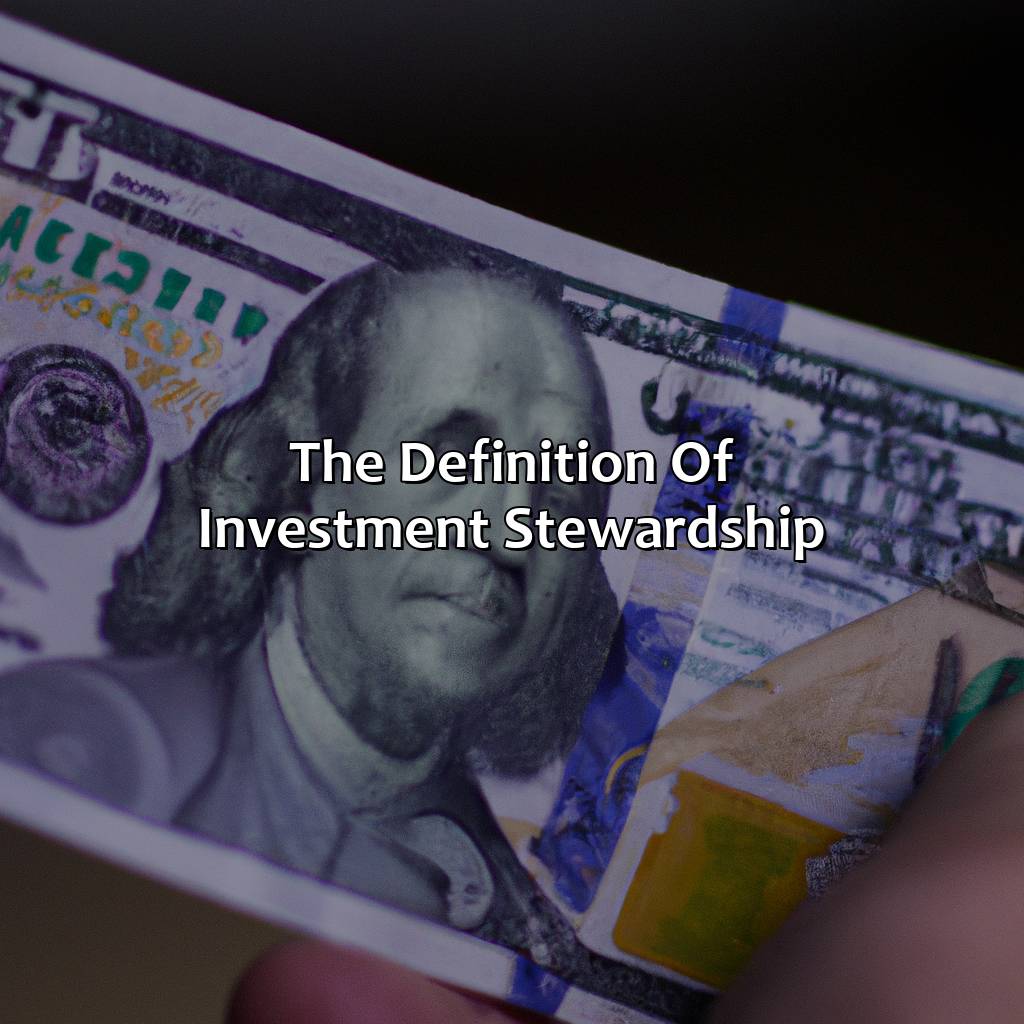What Is Investment Stewardship?
Key Takeaway:
- Investment stewardship refers to the responsible management of investments with a long-term focus on creating sustainable outcomes for both investors and society as a whole.
- Investment stewardship involves principles such as active ownership, responsible engagement, and seeking sustainable outcomes, which help ensure investments are managed in a way that aligns with the values and goals of investors.
- Adopting investment stewardship practices can lead to enhanced returns, improved risk management, and a positive impact on society and the environment, making it a valuable strategy for investors looking to make a meaningful difference through their investments.
Feeling lost and confused about investing? You are not alone. Investment stewardship is a vital tool for investors who want to manage their portfolios wisely. With this guide, learn how to identify and assess your investments to make sure you are getting the most out of them.
What is Investment Stewardship?
Investment stewardship pertains to the management and protection of assets entrusted by investors to institutional investment managers. It involves working in the best interest of the investor, and ensuring that the management decisions made are responsible and ethical. The aim is to generate long-term sustainable value and prevent unnecessary risk-taking.
Investment stewardship goes beyond the traditional understanding of investment management, as it includes a strong focus on environmental, social, and governance factors. It emphasizes active engagement with companies, voting on shareholder resolutions, and advocating for change when necessary. Investment stewardship is a multifaceted approach that involves setting clear objectives, regularly monitoring progress, and holding managers accountable.
It is important for individuals and institutions to understand investment stewardship and actively seek investment managers who prioritize it. By doing so, they are not only protecting their assets but also contributing to responsible and sustainable business practices.
Investment stewardship is a vital aspect of investment management, and should not be overlooked. Those who neglect to prioritize it may be limiting their potential for long-term growth and success. By working with investment managers who prioritize investment stewardship, investors can help ensure a better future for themselves and the world around them.

Image credits: retiregenz.com by Joel Duncun
The Definition of Investment Stewardship
Investment Stewardship is the practice of responsibly managing investments on behalf of clients by considering environmental, social and governance (ESG) factors. Companies that exhibit sustainable business practices and ethical conduct are preferred, which may promote long-term growth and stability. This approach aims to align investment decisions with the values and expectations of clients, while promoting transparency and accountability. It is an evolving and significant shift in corporate culture as it prioritizes environmental and social concerns. By adopting investment stewardship, investors can drive change in corporate practices and positively impact society.

Image credits: retiregenz.com by Yuval Jones
The Importance of Investment Stewardship
Investment stewardship is the responsible management of investments to achieve sustainable long-term outcomes. By considering environmental, social and governance factors, investment managers can identify and mitigate risks and opportunities that impact the value of investments. Investment stewardship also involves engagement with companies and advocating for better practices.
It is important for investors to prioritize investment stewardship to ensure the long-term success of their investments. Furthermore, as investors increasingly demand sustainable investments, investment stewardship is becoming a crucial part of successful investment management. It is vital to consider investment stewardship in investment decision-making to achieve long-term value creation for investors and the broader society.
A recent report by the Principles for Responsible Investment highlights that investment stewardship plays a key role in promoting sustainable investments.

Image credits: retiregenz.com by Yuval Woodhock
Principles of Investment Stewardship
To get to grips with investment stewardship, active ownership, and sustainable outcomes, you must have a long-term strategy. Take a proactive role in the companies you invest in. Ensure ESG (environmental, social, governance) factors are taken into account. Responsible engagement can lead to changes in corporate conduct. Seeking sustainable outcomes guarantees future wealth and equilibrium.

Image credits: retiregenz.com by James Washington
Active Ownership
Investment Stewardship involves actively engaging with portfolio companies to promote long-term value creation. This practice emphasizes collaborative and proactive ownership, prioritizing strategic decisions that consider ESG factors. Effective Investment Stewardship allows investors to use their power and influence for positive change while mitigating risk. By encouraging better accountability and transparency from companies, stewardship bolsters sustainable financial outcomes.
In addition to promoting responsible behavior, active Ownership facilitates transparency in businesses by enabling an open dialogue between stakeholders and portfolio companies. It brings investor voices to the table, acting as catalysts for corporate improvements that benefit all parties involved. Active Ownership entails monitoring how a company performs on ESG metrics, influencing board composition and diversity through voting, proposing processes that aid business development while optimizing operations efficiently.
Historically in the finance industry, investment processes often leaned more towards reactive measures once investments had already been made Instead of proactive measures during the investment selection process. The focus was entirely on mitigating risk without considering long-term value creation within the portfolio companies. However, Investment Stewardship practices are pushing against old ways of thinking by advocating for more engaged investing strategies with enhanced due diligence measures – ultimately creating Value for all parties involved within the ecosystem.
Engagement is a lot like dating – if you want it to work, you better be responsible.
Responsible Engagement
Engaging responsibly with investees is vital for investment stewardship. This involves proactively communicating and working with companies to improve their environmental, social, and governance practices. Stewardship investors prioritize dialogue over proxy voting and aim to build long-standing relationships with investees based on trust and mutual respect.
A collaborative approach allows investors to influence change that will lead to sustainable growth and long-term value creation. Responsible engagement helps in identifying risks faced by businesses, improving transparency, developing solutions for common challenges, and maximizing opportunities aligned with the company’s strategy.
Investment managers representing diverse investor base have established principles of responsible engagement with specific guidelines for constructive dialogues aimed at improving the quality of board effectiveness, executive remuneration plans, transparency around risk factors and governance structures across geographies.
Pro Tip: To ensure effective engagement with investees it is important to establish a clear communication plan built around objectives that are transparent and collaborative in nature.
Investment stewardship may not solve all the world’s problems, but at least we’re seeking sustainable outcomes instead of just pretending everything’s fine.
Seeking Sustainable Outcomes
Investment stewardship involves seeking long-term, sustainable outcomes for investments. This involves actively engaging with companies to promote positive changes in their environmental, social, and governance practices. By aligning with investors who share similar values, investment stewardship can have a significant impact on the companies that are being invested in.
To achieve these sustainable outcomes, investment stewardship typically focuses on active ownership and engagement. This includes sharing information with other investors and using collective influence to push for positive change. Investment stewardship also often involves prioritizing investments in companies that prioritize sustainability practices.
Moreover, seeking sustainable outcomes also requires identifying risks associated with investing in specific industries or companies. To mitigate these risks, investment stewardship aims to diversify portfolios and move away from investments that are harmful to people or the environment.
Investors can improve sustainability outcomes by engaging with companies directly or by investing in those funds that take an active role in promoting positive change through activities such as voting at shareholder meetings or dialoguing directly with company management. Additionally, investment managers can incentivize sustainability goals in companies through metrics such as executive compensation tied to sustainability performance KPIs.
Being a responsible investor not only feels good, but it also pays off – both financially and morally.
Benefits of Investment Stewardship
Investment stewardship can bring benefits! Enhanced returns, improved risk management, plus a positive impact on society and environment. Prioritize investment stewardship for better returns, less risk, and a more positive world around you.

Image credits: retiregenz.com by James Jones
Enhanced Returns
Enhance investment yields with optimal governance and accountability measures. By implementing investment stewardship principles, investors can realize better returns without compromising on risk management. Effective shareholder engagement, company oversight and reporting, and adherence to sustainability standards all contribute to enhanced profitability.
By closely monitoring the financial performance of companies in which they invest, asset managers can identify inefficiencies or corporate governance issues that could negatively affect their investments. With investment stewardship processes in place, investors can mitigate risk through constructive communication with board members or by intervening directly if necessary. Additionally, development of a robust proxy voting policy ensures companies align themselves with investor priorities and long-term financial stability.
Through adoption of Environmental Social Governance (ESG) standards, a commitment to diversity in the workplace and reduction of carbon footprint investments can contribute positively to society while continuing to generate economic value for investors. Furthermore, greater transparency over investment decisions fosters trust between the client and asset manager.
As per BlackRock’s Annual Sustainability Report (2020), “companies that have demonstrated progress against prominent industry frameworks – such as the Task Force on Climate-related Financial Disclosures (TCFD) – are more likely to be seen as well-managed businesses”.
Why take risks when you can manage them? Investment stewardship for those who like to play it safe.
Improved Risk Management
Effective Investment Stewardship leads to Advanced Risk Control. One of the major benefits of Investment Stewardship is that it guarantees successful risk control by ensuring a comprehensive investment approach across all asset classes. This makes it easier for investors to identify and manage potential risks, thus leading to better portfolio performance.
Investment Stewardship also fosters a culture of responsible investing through active engagement with companies on critical issues like environmental sustainability, social responsibility, and corporate governance. By observing these best practices, investors can anticipate changes in market dynamics while proactively managing risks and facilitating long-term value creation.
Investment Stewardship heightens investor confidence by enhancing overall transparency. With the institution of regular reporting policies and public disclosure standards, transparency improves regulatory compliance while providing insights into overall company performance. Investors subsequently gain a deeper understanding of company attitudes towards ethical matters affecting their investment portfolios.
By taking advantage of Investment Stewardship’s benefits, investors can ensure that their assets are future-proofed against any foreseeable upheavals. Failure to adopt these sound management practices means missing out on the gains that accrue from effective risk management and timely decision-making to boost portfolio returns.
Who knew that responsible investing could make you feel better about yourself than that time you recycled a plastic bottle?
Positive Impact on Society and the Environment
Investment Stewardship can have a significant positive impact on both society and the environment. Promoting responsible governance, companies are held accountable for their impact on these areas, encouraging sustainability and social responsibility. This shift towards sustainable investing has also led to an increase in investment opportunities in renewable energy, healthcare, education and other socially impactful sectors.
By utilizing investment stewardship principles, investors can advocate for change, influence corporate policies and push for better practices that benefit society and the environment. Key issues such as climate change risk mitigation and human rights violations can be addressed through engagement with companies by using the power of voting rights and shareholder resolutions.
Additionally, companies that demonstrate good corporates governance practices tend to perform better financially than those who do not prioritize social responsibility. By supporting these socially responsible companies through investment stewardship strategies, investors can build a more sustainable portfolio while actively contributing to the greater good.
Pro Tip: Consider engaging with like-minded individuals or groups to further expand your reach when advocating for positive societal and environmental impact through investment stewardship strategies.
Five Facts About Investment Stewardship:
- ✅ Investment stewardship refers to the responsible management of investments to maximize long-term value and benefit, while taking into account environmental, social, and governance (ESG) factors. (Source: BlackRock)
- ✅ Shareholders may engage in investment stewardship activities by voting in shareholder meetings, engaging in dialogues with companies, and filing shareholder proposals. (Source: Harvard Law School Forum on Corporate Governance)
- ✅ Investment stewardship has gained prominence in recent years, with institutional investors such as BlackRock and Vanguard advocating for companies to act in the best interest of shareholders. (Source: Financial Times)
- ✅ The Principles for Responsible Investment (PRI) is an international initiative promoting investment stewardship by encouraging signatories to incorporate ESG factors into their investment practices and ownership policies. (Source: Principles for Responsible Investment)
- ✅ Investment stewardship requires transparency and accountability from companies and investors as they work to create sustainable and long-term value for stakeholders. (Source: Institutional Investor)
FAQs about What Is Investment Stewardship?
What is investment stewardship?
Investment stewardship refers to the responsible oversight and management of investment assets by institutional investors on behalf of their clients.
What are the key features of investment stewardship?
Investment stewardship involves active engagement with investee companies, proxy voting, monitoring of environmental and social issues, and consideration of long-term value creation for clients.
Which organizations are engaged in investment stewardship activities?
Many institutional investors, including pension funds, sovereign wealth funds, endowments, and foundations, engage in investment stewardship activities.
What is the role of investment stewardship in corporate governance?
Investment stewardship plays a critical role in promoting good corporate governance by actively engaging with companies and exercising voting rights to hold them accountable to shareholders.
How can investment stewardship benefit investors?
Investment stewardship can help investors achieve their financial goals by promoting sustainable, long-term value creation and reducing financial and reputational risks related to environmental and social issues.
What is the future of investment stewardship?
The future of investment stewardship is likely to involve greater focus on ESG issues, increased use of technology and data analytics, and increased collaboration between investors and other stakeholders to promote sustainable business practices.
